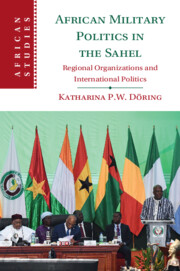Book contents
- African Military Politics in the Sahel
- African Studies Series
- African Military Politics in the Sahel
- Copyright page
- Contents
- Figures
- Tables
- Acknowledgements
- Abbreviations
- Introduction
- 1 Spatial Semantics in African Military Politics
- 2 Combating ‘Sahelistan’
- 3 Challenging the ‘Regions’ of the African Standby Force
- 4 Security and Intelligence Cooperation in the ‘Sahelo-Saharan Region’
- 5 African Military Coalitions and the ‘Core Countries’ in the Sahel
- 6 Towards a Critical Geopolitics of African Military Politics
- Appendix
- Bibliography
- Index
- African Studies Series
3 - Challenging the ‘Regions’ of the African Standby Force
Published online by Cambridge University Press: 02 November 2023
- African Military Politics in the Sahel
- African Studies Series
- African Military Politics in the Sahel
- Copyright page
- Contents
- Figures
- Tables
- Acknowledgements
- Abbreviations
- Introduction
- 1 Spatial Semantics in African Military Politics
- 2 Combating ‘Sahelistan’
- 3 Challenging the ‘Regions’ of the African Standby Force
- 4 Security and Intelligence Cooperation in the ‘Sahelo-Saharan Region’
- 5 African Military Coalitions and the ‘Core Countries’ in the Sahel
- 6 Towards a Critical Geopolitics of African Military Politics
- Appendix
- Bibliography
- Index
- African Studies Series
Summary
Chapter 3 details how, after controversies over the African-led deployment to Mali, political and bureaucratic elites from South Africa and the African Union Commission (AUC) introduced the African Capacity for Immediate Response to Crises (ACIRC), an arrangement for robust military interventions. The chapter analyzes how ACIRC challenged the established spatial semantics of the African Standby Force (ASF) that divided the continent into five regions. By bypassing regional organizations, the cornerstones for multilateral deployment, member states would be able to negotiate military coalitions among themselves and directly with the AUC, giving individual states more control. ACIRC created a relational space not constructed on geographically contiguous regions, but on a network of member states with the self-image of being committed to joint independent military action. In African military politics, ACIRC was an attempt by President Jacob Zuma to position South Africa as a continental military leader that was willing and able to guide interventions. The chapter ends by analyzing how in 2015 ACIRC was discussed as potentially providing the military response to Boko Haram violence in West Africa. This revealed political tensions between Nigerian representatives (that were critical of ACIRC) and South African and Tanzanian representatives.
Keywords
- Type
- Chapter
- Information
- African Military Politics in the SahelRegional Organizations and International Politics, pp. 87 - 112Publisher: Cambridge University PressPrint publication year: 2023

